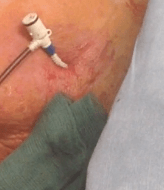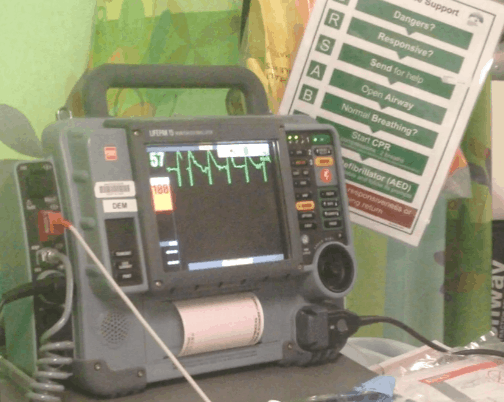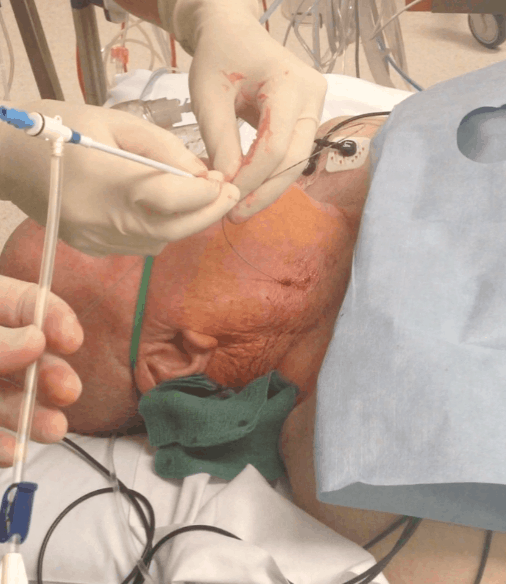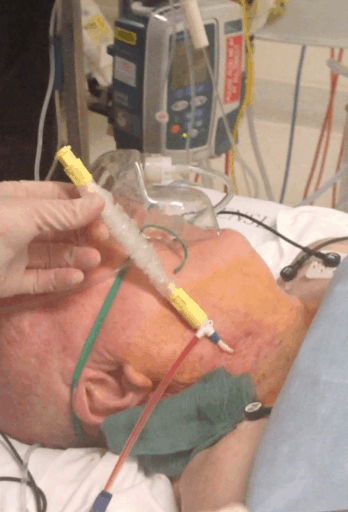This case study involves an elderly gentleman who needed trans-venous pacing.
Here is a simple how to. A 65 yo male is brought in by ambulance. They were called as he had a syncopal episode. When they arrived he was bradycardic and had a slightly depressed conscious state. His systolic BP was 60 mmHg and they had difficulty finding his pulse. Here is the ECG trace they had:
The ECG shows a high level block. A QRS is conducted every so often, but the PP interval is not constant. The ambulance service had tried a atropine and due to the patients continued hypotension paced the patient with external cardiac pacing. On arrival he had a stable BP, was slightly sedated and was twitching with every impulse.
In the ED, more atropine and even adrenaline was tried. An isoprenaline infusion commenced. With no pacing, i.e.., turning it off, the patient kept losing his BP.
It was decided that given that he required definitive treatment and transport to another facility to get this, a trans-venous pacing wire would be floated to provide more definitive care. Ambulance was getting ready, the cardiologists were getting their lab ready and the pacing wire was put in.
TRANS-VENOUS PACING- A HOW TO
Indications
- Patient not tolerating transcutaneous pacing
- Transcutaneous not actively capturing
- Unstable and needing transfer
Anatomical Placement
The aim is to place the catheter into the right internal jugular vein. If this is not possible, the left subclavian may be used. The aim is to pass the pacing wire into the right ventricle. These two routes provide the most direct path.
Equipment
- A Cordis 6 french catheter. It has a balloon on the end and a single side port for medications
- The pacer catheter
- A Pacer sheath
- The pacer box
- A central line kit
Procedure
Use a central line kit to insert a guide wire into the right internal jugular vein. Ultrasound can be used to help here.
The Cordis is a right angled set of tubing shown below. It is basically a wider sheath with a side port that can be used to inject.
Using a Seldinger technique, feed the cordis over the guide wire. As you can see there is a dilator(blue end at the top of the cordis already in place, but a small cut to the skin may be needed to allow it to pass
When in position, the dilator that is part of the cordis can be removed and the catheter left in place. Blood will not come back up the catheter as it has an inbuilt diaphragm.
You are now ready to put the pacing wire in. The temporary pacing wire comes in a pack separately. With it come two black electrodes at the end of the wire and in this case two yellow electrodes that fit into these black electrodes and then to the generator box.
Remember to place the sheath in place as shown below.
This has a balloon at its tip. Test it with 1.5ml of air.
Put the sheath over the pacer before putting it into the cords.However in this case the wire can be passed through the sheath
You can pass the pacing wire blind through the cordis to a length of 15 cm. You should now be in the central venous system.
Inflate the balloon with 1.5ml of air and lock it. The balloon will stay up whilst the pacing wire is being placed in the right location. The balloon assists by moving towards the heart with the flow of blood. Ultrasound may be used very effectively here to see the wire passing into the right position.
A second person should set up the pulse generator. Some have a preset emergency setting. If not start at a heart rate of 80 beats per minute and current of 20mA.
With the generator come two black electrical ports and two red/yellow adaptors. The red/yellow adaptors slide into the black ports. The pacing catheter has 2 wires. The shorter inserts into the positive port, the longer wire into the negative.
 Advance the pacer wire until capture is achieved.
Advance the pacer wire until capture is achieved. 
The aim is to have the tip of the wire at the apex of the right ventricle. This is where ultrasound is great.
When capture is achieved, deflate the balloon, but leave the syringe attached. Ensure the sheath covers the pacer wire and is locked.
Suture the cordis into place.
Adjust the current down so that capture is achieved… and voila!
















